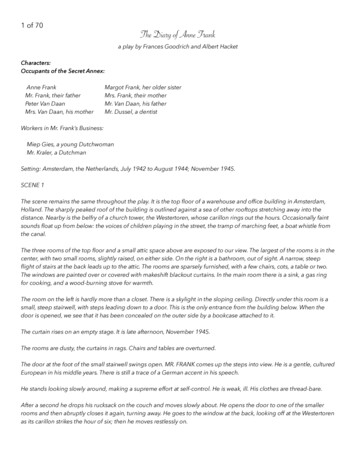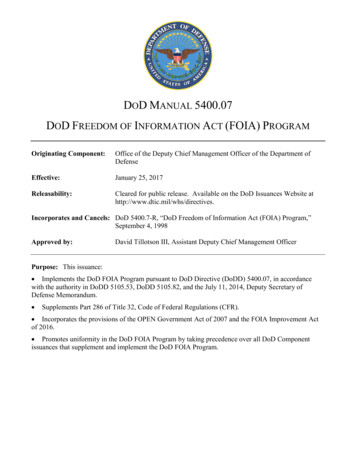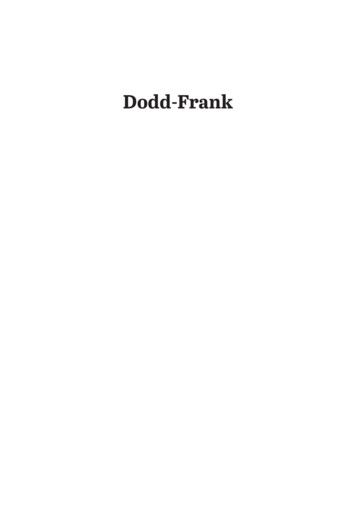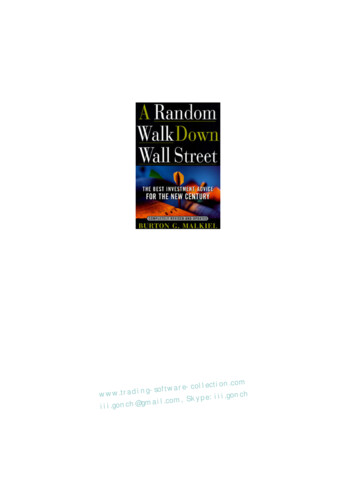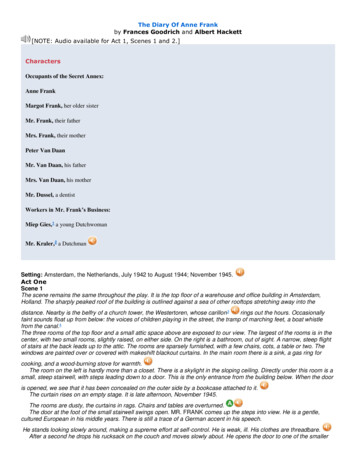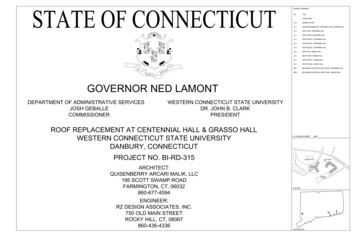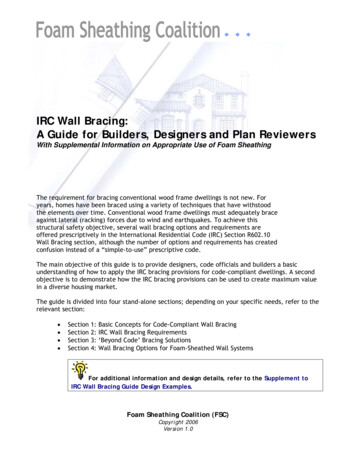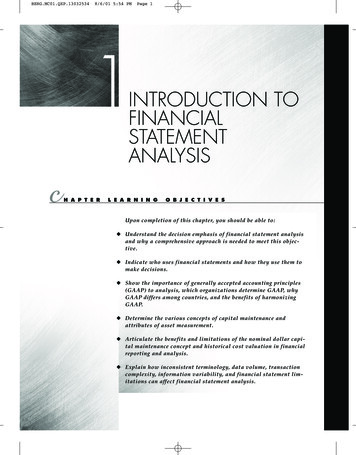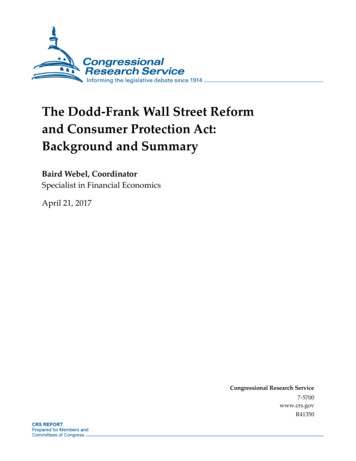
Transcription
The Dodd-Frank Wall Street Reformand Consumer Protection Act:Background and SummaryBaird Webel, CoordinatorSpecialist in Financial EconomicsApril 21, 2017Congressional Research Service7-5700www.crs.govR41350
The Dodd-Frank Wall Street Reform and Consumer Protection ActSummaryBeginning in 2007, U.S. financial conditions deteriorated, leading to the near-collapse of the U.S.financial system in September 2008. Major commercial banks, insurers, government-sponsoredenterprises, and investment banks either failed or required hundreds of billions in federal supportto continue functioning. Households were hit hard by drops in the prices of real estate andfinancial assets, and by a sharp rise in unemployment. Congress responded to the crisis byenacting the most comprehensive financial reform legislation since the 1930s.Then-Treasury Secretary Timothy Geithner issued a reform plan in the summer of 2009 thatserved as a template for legislation in both the House and Senate. After significant congressionalrevisions, President Obama signed H.R. 4173, now titled the Dodd-Frank Wall Street Reform andConsumer Protection Act (P.L. 111-203), into law on July 21, 2010.Perhaps the major issue in the financial reform legislation was how to address the systemicfragility revealed by the crisis. The Dodd-Frank Act created a new regulatory umbrella groupchaired by the Treasury Secretary—the Financial Stability Oversight Council (FSOC)—withauthority to designate certain financial firms as systemically important and subjecting them andall banks with more than 50 billion in assets to heightened prudential regulation. Financial firmswere also subjected to a special resolution process (called “Orderly Liquidation Authority”)similar to that used in the past to address failing depository institutions following a finding thattheir failure would pose systemic risk.The Dodd-Frank Act made other changes to the regulatory structure. It created the Office ofFinancial Research to support FSOC. The act consolidated consumer protection responsibilities ina new Bureau of Consumer Financial Protection (CFPB). It consolidated bank regulation byreassigning the Office of Thrift Supervision’s (OTS’s) responsibilities to the other bankingregulators. A federal office was created to monitor insurance. The Federal Reserve’s emergencyauthority was amended, and its activities were subjected to greater public disclosure and oversightby the Government Accountability Office (GAO).Other aspects of Dodd-Frank addressed particular sectors of the financial system or selectedclasses of market participants. Dodd-Frank required more derivatives to be cleared and tradedthrough regulated exchanges, reporting for derivatives that remain in the over-the-counter market,and registration with appropriate regulators for certain derivatives dealers and large traders.Hedge funds were subject to new reporting and registration requirements. Credit rating agencieswere subject to greater disclosure and legal liability provisions, and references to credit ratingswere required to be removed from statute and regulation. Executive compensation andsecuritization reforms attempted to reduce incentives to take excessive risks. Securitizers weresubject to risk retention requirements, popularly called “skin in the game.” It made changes tobank regulation to make bank failures less likely in the future, including prohibitions on certainforms of risky trading (known as the “Volcker Rule”). It created new mortgage standards inresponse to practices that caused problems in the foreclosure crisis.This report reviews issues related to financial regulation and provides brief descriptions of majorprovisions of the Dodd-Frank Act, along with links to CRS products going in to greater depth onspecific issues. It does not attempt to track the legislative debate in the 115th Congress.Congressional Research Service
The Dodd-Frank Wall Street Reform and Consumer Protection ActContentsIntroduction . 1Legislative History . 2Financial Crisis. 2The Dodd-Frank Wall Street Reform and Consumer Protection Act of 2010 (P.L. 111203) . 4Systemic Risk . 4Financial Crisis Context . 4Provisions in the Dodd-Frank Act (Titles I and VIII) . 4Federal Reserve . 5Financial Crisis Context . 5Provisions in the Dodd-Frank Act (Title XI) . 6Resolution Regime for Failing Firms . 6Financial Crisis Context . 6Provisions in the Dodd-Frank Act (Title II) . 8Securitization. 9Financial Crisis Context . 9Provisions in the Dodd-Frank Act (Title IX) . 10Bank Regulation . 10Financial Crisis Context . 10Provisions in the Dodd-Frank Act (Title I, III, VI, and X) . 12Consumer Financial Protection . 14Financial Crisis Context . 14Provisions in the Dodd-Frank Act (Title X). 16Mortgage Standards . 18Financial Crisis Context . 18Provisions in the Dodd-Frank Act (Title XIV) . 18Derivatives . 19Financial Crisis Context. 19Provisions in the Dodd-Frank Act (Titles VII and XVI) . 19Credit Rating Agencies . 20Financial Crisis Context . 20Provisions in the Dodd-Frank Act (Title IX) . 21Investor Protection . 21Financial Crisis Context . 21Provisions in the Dodd-Frank Act (Title IX) . 22Hedge Funds. 23Financial Crisis Context . 23Provisions in the Dodd-Frank Act (Title IV) . 25Executive Compensation and Corporate Governance . 26Financial Crisis Context . 26Provisions in the Dodd-Frank Act (Title IX) . 26Insurance . 27Financial Crisis Context . 27Provisions in the Dodd-Frank Act (Title V) . 27Miscellaneous Provisions in the Dodd-Frank Act . 28Congressional Research Service
The Dodd-Frank Wall Street Reform and Consumer Protection ActFiguresFigure 1. Changes to Thrift Regulation . 13Figure 2. Changes to Consumer Protection Regulation . 17TablesTable 1. Overview of Federal Financial Regulators Discussed in this Report . 1Table 2. Membership of the Financial Stability Oversight Council . 5Table A-1. Selected Statutory Changes to the Dodd-Frank Act . 29AppendixesAppendix A. Statutory Changes to the Dodd-Frank Act . 29ContactsAuthor Contact Information . 30Congressional Research Service
The Dodd-Frank Wall Street Reform and Consumer Protection ActIntroductionIn response to problems raised by the 2007-2009 financial crisis, the Dodd-Frank Wall StreetReform and Consumer Protection Act of 20101 (Dodd-Frank) was enacted on July 21, 2010.Since enactment, there has been congressional debate over whether—and how much—the actshould be amended. Proponents believe that Dodd-Frank has successfully created a more stablefinancial system and better protected consumers and investors, while opponents believe that theact is partly to blame for restricted credit availability and the sluggish economic recovery that, insome ways, persists to this day. It should be noted that while Dodd-Frank is the largest source ofnew financial regulations since the crisis, it is not the only one.2This report provides a brief summary of the major provisions of the Dodd-Frank Act and howthey relate to the financial crisis. It begins with a table (Table 1) listing the financial regulatorsdiscussed in the report, followed by a summary of the act’s legislative history and the financialcrisis.Table 1. Overview of Federal Financial Regulators Discussed in this ReportName/AcronymComposition/General ResponsibilitiesRegulatorsCommodity Futures Trading Commission (CFTC)Regulation of derivatives marketsConsumer Financial Protection Bureau (CFPB)Regulation of financial products for consumer protectionFederal Deposit Insurance Corporation (FDIC)Provision of deposit insurance, regulation of banks,receiver for failing banksFederal Housing Finance Agency (FHFA)Regulation of housing-government sponsored enterprisesFederal Reserve System (Fed)Monetary policy; regulation of banks, systemicallyimportant financial institutions, and the payment systemFederal Trade Commission (FTC)Regulation of nondepository lending institutions prior tothe Dodd-Frank ActNational Credit Union Administration (NCUA)Provision of deposit insurance, regulation of creditunions, receiver for failing credit unionsOffice of the Comptroller of the Currency (OCC)Regulation of banksSecurities and Exchange Commission (SEC)Regulation of securities marketsOther Federal Financial EntitiesFinancial Stability Oversight Council (FSOC)Council of financial regulators and state and industryrepresentatives accountable for financial stabilityOffice of Financial Research (OFR)Provides research support to FSOCFederal Insurance Office (FIO)Monitors insurance industry and represents federalinterests in insuranceSource: Table compiled by the Congressional Research Service (CRS).1P.L. 111-203.For example, the Basel III accord was a significant source of new post-crisis banking regulations. For moreinformation, see CRS Report R44573, Overview of the Prudential Regulatory Framework for U.S. Banks: Basel III andthe Dodd-Frank Act, by Darryl E. Getter.2Congressional Research Service1
The Dodd-Frank Wall Street Reform and Consumer Protection ActLegislative HistoryThe 111th Congress considered several proposals to reorganize financial regulators and to reformthe regulation of financial markets and financial institutions. Following House committeemarkups on various bills addressing specific issues, then-Chairman Barney Frank of the HouseCommittee on Financial Services introduced the Wall Street Reform and Consumer ProtectionAct of 2009 (H.R. 4173), incorporating elements of numerous previous bills.3 After two days offloor consideration, the House passed H.R. 4173 on December 11, 2009, on a vote of 232-202.Then-Chairman Christopher Dodd of the Senate Committee on Banking, Housing, and UrbanAffairs issued a single comprehensive committee print on November 16, 2009, the RestoringAmerican Financial Stability Act of 2009. This proposal was revised over the following months,and the Restoring American Financial Stability Act of 2010 was marked up in committee onMarch 22, 2010, and reported as S. 3217 on April 15, 2010. The full Senate took up S. 3217 andamended it several times, finishing consideration on May 20, 2010, when it substituted the text ofS. 3217 into H.R. 4173. The Senate then passed its version of H.R. 4173 on a vote of 59-39.Following a conference committee, the House on June 30, 2010, agreed to the H.R. 4173conference report by a vote of 237-192. The Senate agreed to the report on July 15, 2010, by avote of 60-39. The legislation was signed into law on July 21, 2010, as P.L. 111-203.In addition to Chairman Dodd’s and Chairman Frank’s bills, other proposals were made but notscheduled for markup. For example, then-House Financial Services Committee Ranking MemberSpencer Bachus introduced a comprehensive reform proposal, the Consumer Protection andRegulatory Enhancement Act (H.R. 3310), and offered a similar amendment (H.Amdt. 539)during House consideration of H.R. 4173. In March 2008, then-Treasury Secretary Hank Paulsonissued a “Blueprint for a Modernized Financial Regulatory Structure.”4 The ObamaAdministration released “Financial Regulatory Reform: A New Foundation”5 in June 2009, andfollowed this with specific legislative language that provided a base text for congressionalconsideration.Financial CrisisUnderstanding the fabric of financial reform proposals requires some analysis both of financialdisruptions that peaked in September 2008, as well as of more enduring concerns about risks inthe financial system.6The financial crisis focused policy attention on systemic risk, which had previously been asubject of interest to academics and central bankers, but was not seen as a significant threat toeconomic stability. The last major systemic risk episode was sparked by bank runs in the GreatDepression, and the main elements of the current bank regulatory regime and federal safety netwere put in place to prevent a similar recurrence. Between the end of the Great Depression andthe early 2000s, the financial system weathered numerous shocks, failures, and crashes, with3Initially incorporated bills included H.R. 2609, H.R. 3126, H.R. 3269, H.R. 3817, H.R. 3818, H.R. 3890, and H.R.3996.4U.S. Treasury, Blueprint for a Modernized Financial Regulatory Structure, March 2008, at es/Documents/Blueprint.pdf.5U.S. Treasury, Financial Regulatory Reform: A New Foundation, June 17, 2009, at s/Pages/20096171052487309.aspx.6See, for example, “The Panic of 2008,” a speech given by Federal Reserve Governor Kevin Warsh on April 6, 2009,for discussion of aspects of typical financial panics and historical examples, available at rsh20090406a.htm.Congressional Research Service2
The Dodd-Frank Wall Street Reform and Consumer Protection Actlimited spillover into the real economy. Typically, the Federal Reserve (Fed) would announce thatit stood ready to provide liquidity to the system, and that proved sufficient to stem panic. The ideathat a financial shock could cause the entire system to spin out of control and collapse, and thatthe flow of credit might stop altogether, seemed to be a remote prospect. De facto policy was torely on the Fed to deal with crises after the fact.The events of 2007 and 2008 caused a sharp reassessment of the robustness and the selfstabilizing capacity of the financial system. As then-Treasury Secretary Timothy Geithner notedin written testimony delivered to the House Financial Services Committee on September 23,2009, “The job of a financial system is to efficiently allocate savings and risk. Last fall, ourfinancial system failed to do its job, and came precariously close to failing altogether.”7A number of discrete failures in individual markets and institutions led to global financial panic.Notably, many of these failures were not banks, seen historically as the primary source ofsystemic risk. U.S. financial firms suffered heavy losses in 2007 and 2008, primarily because ofdeclines in the value of mortgage-related assets. During September 2008, Fannie Mae andFreddie Mac were placed in government conservatorship. Merrill Lynch was sold in distress toBank of America in a deal supported by the Fed and Treasury. The Fed and Treasury failed to finda buyer for Lehman Brothers, which subsequently filed for bankruptcy, disrupting financialmarkets. A money market mutual fund (the Reserve Primary Fund) that held debt issued byLehman Brothers announced losses, triggering a run on other money market funds, and Treasuryresponded with a guarantee for money market funds. The American International Group (AIG),an insurance conglomerate with a securities subsidiary that specialized in financial derivatives,including credit default swaps, was unable to post collateral related to its derivatives andsecurities lending activities. The Fed intervened with an 85 billion loan to prevent bankruptcyand to ensure full payment to AIG’s counterparties. In response to the general panic, Congressapproved the 700 billion Troubled Asset Relief Program (TARP); the Fed introduced severallending facilities to provide liquidity to different parts of the financial system; and the FederalDeposit Insurance Corporation (FDIC) introduced a debt guarantee program for banks.8 The paniclargely subsided through the latter part of 2008, although confidence in the financial systemreturned very slowly.It was widely understood that the panic had its roots in the subprime mortgage market, in whichyears of double-digit housing price increases had fed a bubble mentality and caused lenders torelax underwriting standards. That the housing market would cool, as it began to do in 2006, wasnot a great surprise. What was generally unexpected was the way losses caused by risingforeclosures and bad loans rippled through the system. Major financial institutions hadconstructed highly leveraged speculative positions that magnified the subprime shock, so that asetback in a 1 trillion segment of the U.S. housing market generated many times that amount infinancial losses.Giant financial institutions were shown to be vulnerable to liquidity runs, and many failed or hadto be rescued as short-term credit dried up. The value of complex financial instruments createdthrough securitization became completely uncertain, and market participants lost confidence ineach other’s creditworthiness. Risks that were thought to be unrelated became highly correlated; a7Treasury Secretary Timothy F. Geithner, Written Testimony on Financial Regulatory Reform, in U.S. Congress,House Committee on Financial Services, The Administration’s Proposals for Financial Regulatory Reform, 111thCong., 1st sess., September 23, 2009, at ings/111/printed%20hearings/111-76.pdf.8For more information see CRS Report R43413, Costs of Government Interventions in Response to the FinancialCrisis: A Retrospective, by Baird Webel and Marc Labonte.Congressional Research Service3
The Dodd-Frank Wall Street Reform and Consumer Protection Actnegative spiral that showed all financial risk taking to be interconnected and all declines to beself-reinforcing took hold. Doubts about counterparty exposure were magnified by opacity inderivatives markets.Disruption to the financial system exacerbated recessionary forces already at work in theeconomy. Asset prices plunged and consumers suffered sharp losses in their retirement andcollege savings accounts, as well as in the value of their homes. The financial crisis accelerateddeclines in consumption and business investment, which in turn made banks’ problems worse.Overall, the recession proved to be the deepest and longest since the Great Depression.The Dodd-Frank Wall Street Reform and ConsumerProtection Act of 2010 (P.L. 111-203)The Dodd-Frank Act included measures to improve systemic stability, improve policy options forcoping with failing financial firms, increase transparency throughout financial markets, andprotect consumers and investors. The act included provisions that affected virtually everyfinancial market and that amended existing or granted new authority and responsibility to nearlyevery federal financial regulatory agency.Under each of the areas treated below, the financial crisis context and the correspondingprovisions in the Dodd-Frank Act are included.Systemic RiskFinancial Crisis Context9Systemic risk refers to sources of instability for the financial system as a whole, often through“contagion” or “spillover” effects against which individual firms cannot protect themselves.Although regulators took systemic risk into account before the crisis, and systemic risk can neverbe entirely eliminated, analysts have pointed to a number of ostensible weaknesses in the precrisisregulatory regime’s approach to systemic risk. First, there had been no regulator with overarchingresponsibility for mitigating systemic risk. Some analysts argue that systemic risk can fester inthe gaps in the regulatory system where one regulator’s jurisdiction ends and another’s begins.Second, the crisis revealed that liquidity crises and runs were not just a problem for depositoryinstitutions. Third, the crisis revealed that nonbank, highly leveraged firms, such as LehmanBrothers and AIG, could be a source of systemic risk and “too big (or too interconnected) to fail.”Finally, there were concerns that the breakdown of different payment, clearing, and settlement(PCS) systems that make up the “plumbing” of the financial system, which were not regulatedconsistently, could be another source of systemic risk.Provisions in the Dodd-Frank Act (Titles I and VIII)Rather than creating a dedicated systemic risk regulator with broad powers to neutralize sourcesof systemic risk as they arise, Dodd-Frank instead created a Financial Stability Oversight Council(FSOC), composed of the Treasury Secretary as chair along with eight heads of federal regulatoryagencies (including the newly created Consumer Financial Protection Bureau) and a presidential9For more information, see archived CRS Report R40877, Financial Regulatory Reform: Systemic Risk and theFederal Reserve, by Marc Labonte (available upon request).Congressional Research Service4
The Dodd-Frank Wall Street Reform and Consumer Protection Actappointee with insurance experience as voting members. The act created an Office of FinancialResearch to support the council. See Table 2 below.Table 2. Membership of the Financial Stability Oversight CouncilVoting Members (Heads of)Nonvoting MembersDepartment of the TreasuryOffice of Financial Research (OFR) DirectorFederal Reserve Board (FRB, or the Fed)Federal Insurance Office DirectorOffice of the Comptroller of the Currency (OCC)A state insurance commissionerConsumer Financial Protection Bureau (CFPB)A state bank supervisorSecurities and Exchange Commission (SEC)A state securities commissionerFederal Deposit Insurance Corporation (FDIC)Commodity Futures Trading Commission (CFTC)Federal Housing Finance Agency (FHFA)National Credit Union Administration (NCUA)Insurance expert (appointed by the President)Source: Dodd-Frank §111(b).The council is authorized to identify and advise its member regulators on sources of systemic riskand “regulatory gap” problems, but has limited rulemaking, examination, or enforcement powersof its own. The council is authorized to identify systemically important financial firms regardlessof their legal charter, and the Fed will subject them and all bank holding companies with over 50billion in assets to stricter prudential oversight and regulation, including counterparty exposurelimits set at 25% of total capital, annual stress tests and capital planning requirements, resolutionplanning (“living wills”), early remediation requirements, and risk management standards. Manylarge firms were already regulated by the Fed for safety and soundness as bank holdingcompanies; the act prevented most firms from changing their charter in order to escape Fedregulation (known as the “Hotel California” provision). In addition, the Dodd-Frank Act includeda 10% liability concentration limit for financial firms and mechanisms by which the Fed would beempowered to curb the growth or reduce the size of large firms if they pose a risk to financialstability.10Title VIII also provided for many PCS systems and activities deemed systemically important bythe council to be regulated for safety and soundness by (depending on the type) the Fed, theSecurities and Exchange Commission (SEC), or the Commodities Futures Trading Commission(CFTC) and to have access to the Fed’s discount window in “unusual and exigent circumstances.”Federal ReserveFinancial Crisis Context11During the recent financial turmoil, the Fed engaged in unprecedented levels of emergencylending to nonbank financial firms through its authority under Section 13(3) of the Federal10For more information, see CRS Report R42150, Systemically Important or “Too Big to Fail” Financial Institutions,by Marc Labonte.11For more information, see CRS Report RL34427, Financial Turmoil: Federal Reserve Policy Responses, by MarcLabonte.Congressional Research Service5
The Dodd-Frank Wall Street Reform and Consumer Protection ActReserve Act. At that time, this statute stated that “in unusual and exigent circumstances, the Boardof Governors of the Federal Reserve System, by the affirmative vote of not less than fivemembers, may authorize any Federal reserve bank . to discount for any individual, partnership,or corporation, notes, drafts, and bills of exchange .”12Such loans can be made only if secured to the Fed’s satisfaction and if the targeted borrower isunable to obtain the needed credit through other banking institutions. In addition to the level oflending, the form of the lending was novel, particularly the creation of a series of liquidityfacilities for nonbank financial firms and three limited liability corporations controlled by theFed, to which the Fed lent a total of 72.6 billion to purchase illiquid assets from Bear Stearnsand AIG. The Fed’s actions under Section 13(3) generated debate in Congress about whethermeasures were needed to amend the institution’s emergency lending powers.Provisions in the Dodd-Frank Act (Title XI)The Dodd-Frank Act included several provisions related to the Federal Reserve’s Section 13(3)lending authority. In particular, the act stipulated that, although the Fed may authorize a FederalReserve Bank to make collateralized loans as part of a broadly available credit facility, it may notauthorize a Federal Reserve Bank to lend to only a single and specific individual, partnership, orcorporation. When using this emergency authority, the Fed is required to seek approval from theTreasury Secretary.13 Title XI would also allow the FDIC to set up emergency liquidity programsto guarantee the debt of bank holding companies, similar to the 2008 Temporary LiquidityGuarantee Program.In addition, the Dodd-Frank Act allowed the Government Accountability Office (GAO) to auditthe Fed’s lending facilities and open market operations for internal controls and risk management,and it called for a GAO audit of the Fed’s actions during the crisis. The act required disclosure ofFed borrowers and borrowing terms, but with a time lag. The act prohibited firms regulated by theFed from participating in the selection of directors of the regional Federal Reserve Banks. 14 Theact also created a new preside
some ways, persists to this day. It should be noted that while Dodd-Frank is the largest source of new financial regulations since the crisis, it is not the only one.2 This report provides a brief summary of the major provisions of the Dodd-Frank Act and how they relate to the financial crisis.

